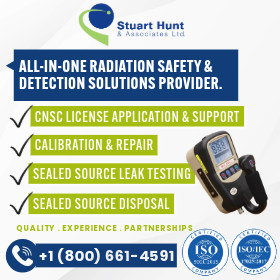Editor’s Message, October 2021
 I’ve been keeping my fingers crossed all year hoping to avoid it, but it’s finally happened: we’re having a virtual Canadian Nuclear Safety Commission (CNSC) inspection at my workplace, University Health Network. I had really hoped the pandemic would be waning so the inspectors could drive down to Toronto by the time our next inspection was due. Alas, it was not to be.
I’ve been keeping my fingers crossed all year hoping to avoid it, but it’s finally happened: we’re having a virtual Canadian Nuclear Safety Commission (CNSC) inspection at my workplace, University Health Network. I had really hoped the pandemic would be waning so the inspectors could drive down to Toronto by the time our next inspection was due. Alas, it was not to be.
I’ll preface this by saying the inspection hasn’t actually happened yet, so maybe it will be better than I expect. I also know we’re one of the largest cancer centres in Canada, so the list of photos and videos CNSC has requested is probably a lot more daunting than it would be at many other locations. At least this is only a Type II inspection—I can’t imagine what that list would look like if this was going to be a full Type I audit.
We’ve published a few articles in the Bulletin over the past year on virtual inspections from the licensee’s perspective. The consensus seems to be that there is a lot of work up front, but in general the process works. However, I think there’s still a big difference between making the process work and making a process that provides results equivalent to an in-person inspection.
I’ve looked over photos, videos, and floor plans of my facility in the past, and I find it very hard to situate myself using those materials alone—and these are areas I’ve actually been in many times. Even when I’m watching a video I’ve recorded myself, it takes me a moment to figure out exactly where I am and what I’m looking at. Until we get some decent virtual-reality technology in the mix, there is simply no substitute for being physically in a space. As a former CNSC inspector, I can’t count the times when drawings or photos and the associated processes clicked only after I was able to actually see the facility in person.
Our previous Bulletin articles identified more focused inspections as one advantage of the virtual process. I’m sure that’s true, but I don’t really want it to be more focused. Licensees already get very little face-to-face time with CNSC staff; even at conferences, there are competing demands on everyone’s time (professional and social).
I like having off-topic discussions with CNSC staff, whether that’s asking the questions that just never seemed important enough to email about, talking about regulatory changes, or just asking for general advice. These types of conversations are important. In fact, these hallway (or “water cooler”) conversations at the workplace are exactly what a lot of staff who have been working remotely (both employers and employees) say they miss.
Finally, it’s hard to feel confident that a virtual inspection can really assess a safety program in the same way as an on-site inspection. Our safety groups at University Health Network (including radiation safety) have been primarily working from home during the pandemic, but we’ve ensured there is always at least one of us on site to respond to incidents or general inquiries. This would have been very difficult to accomplish virtually with the same effect.
University Health Network has issued a mandate that all staff and visitors must be vaccinated, and there are no half measures like regular testing—if you’re not vaccinated, you will be out of a job.
Some CNSC inspectors, due to their work requirements, were able to book vaccination appointments sooner than they would have otherwise been eligible. And most provinces have adopted (or will soon adopt) a vaccine passport system for many non-essential activities, such as going to see a movie. Through these policies, the government is telling people they can go to see a movie if they’re vaccinated, but if that person works for CNSC (or other agencies, I’m sure), they can’t perform a safety inspection in person. “Cinema before safety” is not a phrase I ever expected to write.
For my part, I’m very much looking forward to seeing inspectors in person again.
Do you want to read more articles like this?
The Bulletin is published by the Canadian Radiation Protection Association (CRPA). It’s a must-read publication for radiation protection professionals in Canada. The editorial content delivers the insights, information, advice, and valuable solutions that radiation protection professionals need to stay at the forefront of their profession.
Sign up today and we’ll send you an email each time a new edition goes live. In between issues, check back often for updates and new articles.
Don’t miss an issue. Subscribe now!
Subscribe



